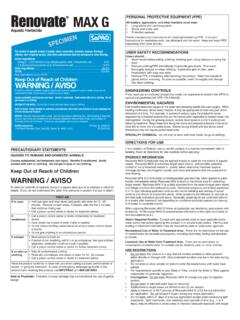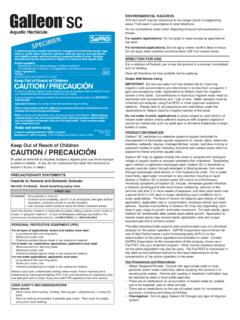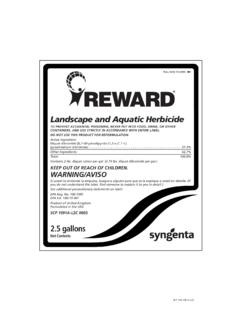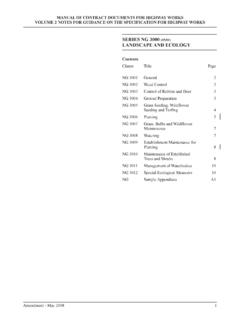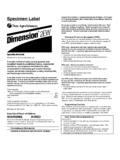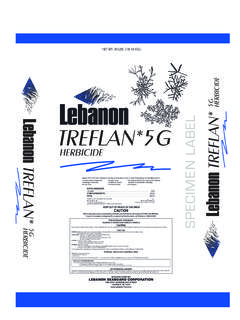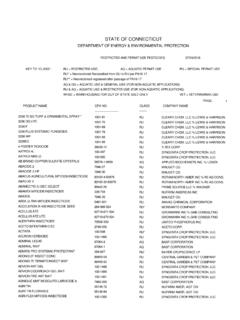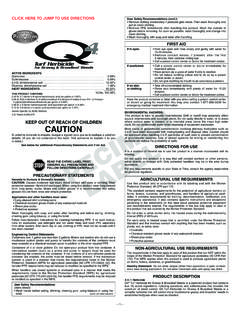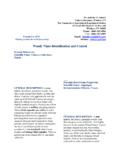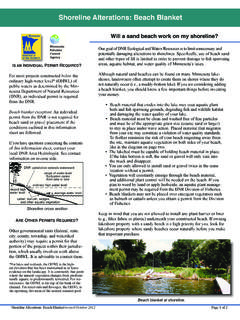Transcription of Renovate MAX G - sepro.com
1 PRECAUTIONARY STATEMENTSHAZARD TO HUMANS AND DOMESTIC ANIMALSC auses substantial, but temporary eye injury. Harmful if swallowed. Avoidcontact with skin or clothing. Do not get in eyes or on clothing. Keep Out of Reach of ChildrenWARNING / AVISOSi usted no entiende la etiqueta, busque a alguien para que se la explique a usted endetalle. (If you do not understand the label, find someone to explain it to you in detail.)Note to Physician:Probable mucosal damage may contraindicate the use of CONTROLSP ilots must use an enclosed cockpit that meets the requirements listed in the WPS foragricultural pesticides [40 CFR (d)(6].ENVIRONMENTAL HAZARDSFish breathe dissolved oxygen in the water and decaying weeds also use oxygen. Whentreating continuous, dense weed masses, it may be appropriate to treat only part of theinfestation at a time. For example, in quiescent waters, apply the product to areasseparated by untreated sections that can be treated after vegetation in treated areas hasdisintegrated.)
2 During the growing season, weeds decompose in a 2 to 4 week periodfollowing treatment. Begin treatment along the shore and proceed outwards in bands toallow fish to move into untreated areas. Waters having limited and less dense weedinfestations may not require partial CHEMICAL:Do not ship or store with food, feeds, drugs or FOR USEIt is a violation of Federal Law to use this product in a manner inconsistent with itslabeling. Read all Directions for Use carefully before INFORMATIONR enovate MAX G herbicide may be applied directly to water for the control of aquaticweeds. Renovate MAX G enhances target weed control, and provides selectivecontrol of many broadleaf weeds in: ponds; lakes; reservoirs; marshes; bayous;drainage ditches; non-irrigation canals; and rivers and streams that are quiescent orslow-flowing. Renovate MAX G is formulated on biodegradable granules that, when applied to waterbodies, immediately deliver Renovate MAX G down to the critical area for controllingtarget weeds.
3 Renovate MAX G is quickly absorbed from the water through plant stemsand foliage and from the hydrosoil by roots. Herbicidal symptoms are initially expressed2 to 14 days following application and usually involve bending and twisting of apicalsections and shoots of susceptible plants. Initial symptoms are followed by necrosis ofterminal buds and above ground tissue. Generally, target plants are controlled within 2to 4 weeks after treatment, but depending on conditions and plant species can take upto 8 weeks for complete applying Renovate MAX G follow all applicable use directions, precautions andlimitations. All Renovate MAX G concentrations referred to in this label are based onacid equivalence ( ).Obtain Required Permits:Consult with appropriate state or local pesticide and/orwater authorities before applying this product in or around pubic waters. Permits andposting or treatment notification may be required by state or local public Use of Water in Treatment Area:There are no restrictions on the useof treated water for recreational purposes, including swimming, fishing and Use of Water from Treatment Area:There are no restrictions onconsumption of treated water for potable use by livestock, pets, or other RESTRICTIONS Do notapply this product in a way that will contact workers or other persons,either directly or through drift.
4 Only protected handlers may be in the area duringapplication. Do not enter or allow people (or pets) to enter the treated area until dusts havesettled. For requirements specific to your State or Tribe, consult the State or Tribal agencyresponsible for pesticide regulation. Chemigation:Do notapply Renovate MAX G through any type of irrigationsystem. Do notapply to tidal salt water bays or estuaries. Applications to target areas are limited to two (2) per season. Apply a maximum of pounds of Renovate MAX G ( lbs )/acre-footper application. Do notexceed ppm during any single application. Do not apply within 21 days of previous application except when conducting splittreatments. Split treatments, over relatively short periods of time ( , 1 to 4days), may be effective in some areas to maintain adequate exposure with targetFIRST AIDIf in eyes Hold eye open and rinse slowly and gently with water for 15 - 20minutes.
5 Remove contact lenses, if present, after the first 5 minutes,then continue rinsing eye. Call a poison control center or doctor for treatment swallowed Call a poison control center or doctor immediately for treatmentadvice. Have person sip a glass of water if able to swallow. Do not induce vomiting unless told to do so by a poison control centeror doctor. Do not give anything to an unconscious inhaled Move person to fresh air. If person is not breathing, call 911 or an ambulance, then give artificialrespiration, preferably mouth-to-mouth if possible. Call a poison control center or doctor for further treatment on skin orclothing Take off contaminated clothing. Rinse skin immediately with plenty of water for 15 - 20 minutes. Call a poison control center or doctor for treatment the product container or label with you when calling a poison control center ordoctor, or going for treatment. In case of emergency endangering health or theenvironment involving this product, call INFOTRACat PROTECTIVE EQUIPMENT (PPE) All loaders, applicators, and other handlers must wear: Long-sleeve shirt and long pants; Shoes and socks; and Protective manufacturer s instructions for cleaning/maintaining PPE.
6 If no suchinstructions for washables exist, use detergent and hot water. Keep and wash PPEseparately from other SAFETY RECOMMENDATIONSU sers should: Wash hands before eating, drinking, chewing gum, using tobacco or using thetoilet. Remove clothing/PPE immediately if pesticide gets inside. Then washthoroughly and put on clean clothing. If pesticide gets on skin, washimmediately with soap and water. Remove PPE immediately after handling this product. Wash the outside ofgloves before removing. As soon as possible, wash thoroughly and changeinto clean MAX GAquatic HerbicideFor control of aquatic weeds in ponds; lakes; reservoirs; marshes; bayous; drainage ditches; non-irrigation canals; and rivers and streams that are quiescent or Ingredients triclopyr: 3,5,6-trichloro-2-pyridinyloxyacetic acid, triethylamine salt .. 2,4-dichlorophenoxyacetic acid, dimethylamine .. equivalence ( ): Out of Reach of ChildrenWARNING / AVISOSi usted no entiende la etiqueta, busque a alguien para que se la explique a usted en detalle.
7 (If you do not understand the label, find someone to explain it to you in detail.)Causes substantial, but temporary eye injury. Harmful if swallowed. Avoid contact with skin or clothing. Do not get in eyes or on clothing. SPECIALITY CHEMICAL: Do not ship or store with food, feeds, drugs or to inside of label booklet for additional precautionary information and directions for use including first aid and storage and : Read the entire label before using. Use only according to label directions. Before buying or using this product, read Terms and Conditions of Use, Warranty Disclaimer, Inherent Risks of Use, and Limitation of Remedies at the end of the label. If terms are unacceptable, return at once Corporation EPA Reg. No. 67690-5011550 North Meridian Street, Suite 600, Carmel, IN 46032 FPL20131105 plants, such as small sites or sites with higher dilution potential. When treating moving bodies of water, applications must be made while travelingupstream to prevent concentration of herbicide downstream from the TO WATERS USED FOR IRRIGATION Irrigation Restrictions Do notuse treated water for irrigating greenhouse or nursery plants unless triclopyrand 2,4-D concentrations are confirmed to be less than 1 ppb as determined usingFasTEST or other analytical techniques.
8 Do notuse water treated with Renovate MAX G for hydroponic farming unlesstriclopyr and 2,4-D concentrations are confirmed to be less than 1 ppb asdetermined using FasTEST or other analytical techniques. Do notapply Renovate MAX G directly to, or otherwise permit it to come intodirect contact with grapes, tobacco, vegetable crops, flowers, or other desirablesusceptible broadleaf plants, and do notpermit dust to drift into these areas. This label describes both required and recommended uses of a chemicalanalyses for the active ingredients, triclopyr and 2,4-D. SePRO Corporationrecommends the use of a FasTEST analysis for the determination of RenovateMAX G concentration in water. Contact SePRO Corporation for the incorporationof these analyses into your treatment program. Other proven chemical analysisfor the active ingredients may also be used. The FasTEST analysis isreferenced in this label as the preferred method for the rapid determination of theconcentration of the active ingredients in the water.
9 Both triclopyr and 2,4-D canbe analyzed from a single water sample. If Renovate MAX G treated water is intended to be used only for crops or non-crop areas that are labeled for direct treatment with triclopyr and 2,4-D such aspastures, turf, or established grasses, the treated water may be used to irrigateand/or mix sprays for these sites at any time during and after application. Due to potential phytotoxicity and/or residue considerations, the followingrestrictions are applicable to other uses of irrigation water:o If treated water is intended to be used to irrigate or mix sprays for crops notlabeled for direct treatment with triclopyr and 2,4-D, the water must not beused unless oneof the following restrictions has been observed: A waiting period of 120 days from the time of application has elapsed; or An approved assay indicates that the triclopyr concentration is ppb orless and the 2,4-D concentration is 100 ppb or less at the water Table 2 (SAMPLING FOR DRINKING WATER ANALYSES) for therecommended waiting periods after application but before taking theinitial water sample at water intake.
10 O If treated water is intended to be used to irrigate non-crop areas not labeledfor direct treatment with triclopyr and 2,4-D ( , landscape ornamentals) orfor other irrigation uses not described, consult with SePRO Corporation priorto commencing irrigation if triclopyr concentrations exceed ppb and 2,4-Dconcentrations are greater than 100 ppb. APPLICATIONS TO POTABLE WATER SOURCESP otable Water Restrictions The potable water use restrictions on this label are to ensure that consumption ofwater by the public is allowed only when the concentration of triclopyr in water isless than 400 ppb and the concentration of 2,4-D in water is less than the MCL(Maximum Contaminant Level) of 70 ppb. Applicators should consider the uniquecharacteristics of the treated waters to assure that triclopyr and 2,4-Dconcentrations in potable water do not exceed 400 ppb and 70 ppb, respectively,at the time of consumption. The drinking water setback distances from functioning potable water intakes areprovided in Table 1 (Drinking Water Setback Distances).



